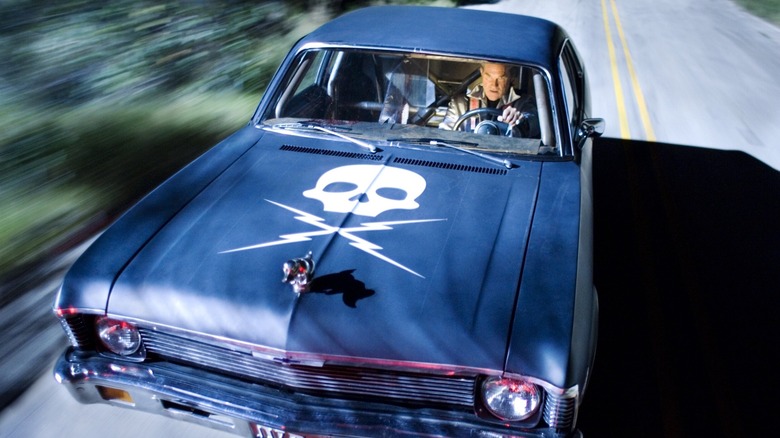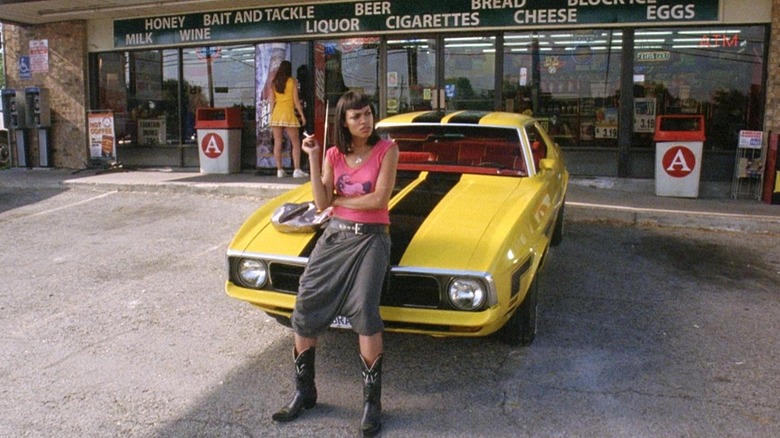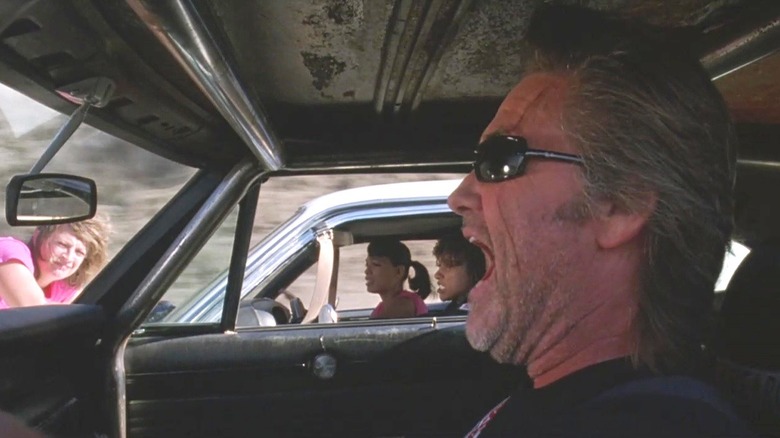How Quentin Tarantino And Robert Rodriguez Found The Idea For Their Grindhouse Double Feature
Since its release in 2007, "Grindhouse" — the drive-in double feature film experiment from Robert Rodriguez and Quentin Tarantino — has aged quite well, which is ironic considering that it was made to look like a deteriorating film print. In competing styles, Rodriguez shot his entry "Planet Terror" digitally, then added artifacts in post to achieve the weathered look of a circulated print. Tarantino filmed "Death Proof" on 35mm, then beat up the physical print by throwing it around and rolling it in the dirt. It's a combination that works beautifully. After the violent, explosive onslaught Rodriguez delivers on digital, the brain has a little time to recover watching QT's shot-on-film slasher.
While the concept for "Grindhouse" went over the heads of a lot of moviegoers at the time, the idea to deliver the equivalent of an old school double feature of exploitation B-movies is still pretty inspired. Given the box office performance of "Grindhouse" and the directing clout that helped get it made in the first place, it's also a theater experience that will probably never be duplicated again. Unless Tarantino and Rodriguez ever do a sequel, of course.
The "Grindhouse" project came at a good time for Tarantino, who wasn't ready to start the arduous task of bringing "Inglourious Basterds" to the screen, a film that many regard as his masterpiece. Time traveling back to 2007 right around the release of "Grindhouse," it's interesting to take a look at Sight & Sound's interview with QT (done in conjunction with their June cover story) to see what the director was thinking at the time and what he remembers about how the concept came together in the first place.
Roger Corman and Mount Everest
At that point, Quentin Tarantino had done an interview with Sight & Sound for every one of his movies (up until "Kill Bill: Volume 1" at least). He's a rare director that truly appreciates the work of a film critic, a reverence that is perfectly clear with his new book "Cinema Speculation." Now, if you think Tarantino has a lot of far out ideas rattling around his head, Robert Rodriguez is actually the true idea man between the two. When Sight & Sound asked about how "Grindhouse" was originally conceived, Tarantino said, at that point in his career, he needed something that was somewhere in-between Roger Corman and Mount Everest. "I'd done 'Kill Bill' and I wanted a little bit more time before I climbed my next Mount Everest," he reflected.
Tarantino had also just filmed the "CSI" fifth season finale episode, "Grave Danger," over two weeks that felt like making another feature film. While he was starting to gear up mentally to take on the challenges of crafting his WWII movie, his old filmmaking pal stopped by his home for an inspired visit. QT told Sight & Sound:
"Robert Rodriguez came over to my house, and he saw I had an old AIP double feature poster of the Roger Corman movie 'Rock All Night' and the film 'Dragstrip Girl.' And he goes, 'You see that double feature poster you have on the wall there? I always wanted to do a double feature movie.' And he was thinking about doing both of them himself."
Luckily, Rodriguez didn't wind up shooting both movies alone. The balance between the sensibilities of both directors dovetailed wonderfully together, and there was no way that Rodriguez would have shot anything on actual film.
The grindhouse franchise that never was
The combination of digital and 35mm make a rare project like "Grindhouse" even more unique. In the end, it was Robert Rodriguez' idea to divide and conquer, suggesting he make one and Quentin Tarantino make the other. Rodriguez already had about 30 pages of a zombie movie written before turning his attention to "The Faculty," and that was all he needed to kick off his horror film "Planet Terror."
Originally, the two movie mavericks of '90s cinema had even bigger dreams for their double feature experience. "We envisioned this being a franchise. It would be fun to keep going back to it — another one could be a spaghetti western or sexploitation or whatever," Tarantino told S&S. Both decided it would be better to make two horror films together, leading Tarantino to abandon a ghost story about an old enslaved person named Jody the Grinder (a role Samuel L. Jackson may have played) to instead make his subversion of a proper genre film with a killer car. Sadly, though, their greater plans for a "Grindhouse" franchise never made it past a single installment.


